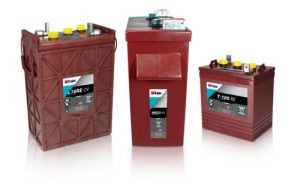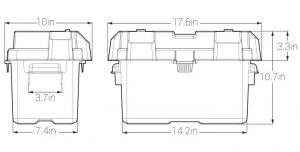Whether you’re living off-grid, camping, or even boating, the battery is of utmost importance – especially when you’re in a rough-terrain environment. Marine batteries have an endurance level and can be an effective power source under mild to extremely heavy loads.
Marine Batteries come in all shapes and sizes. The size of the battery really depends on what you intend to run. They are also three types of marine batteries; starter, deep cycle, and hybrids.
Marine deep cycle batteries differ from other deep-cycle batteries in that they are made specifically for use on marine craft. They are typically heavier and capable of delivering more power.
How Many Amp-Hours in Marine Group Sizes
It’s important to choose the right marine battery group size for your boat. The size of your battery will determine how much power it can provide and how long it will last. The most common group sizes for marine batteries are 24, 27, and 31.
Group 24 batteries are the most popular choice for small to medium-sized boats. They offer a good balance of power and size, and they’re less expensive than larger batteries. Group 27 batteries are a good choice for larger boats that need more power. They’re more expensive than smaller batteries, but they’ll last longer and provide more power.

Group 31 batteries are the largest marine battery size, and they’re the most expensive. They offer the most power and the longest life.
| Group Size | Amp-Hours | Dimensions (Inches) |
| U1 | 31 -34 Ah | 7.76 × 5.16 × 6.26 in |
| 22 NF | 50 – 55 Ah | 9.06 × 5.44 × 8.27 in |
| 24 | 75 – 80 Ah | 10.24 × 6.61 × 8.27 in |
| 27 | 90 – 100 Ah | 12.05 × 6.61 × 8.27 in |
| 30 | 100 -150 Ah | 12.97 × 6.89 × 8.40 in |
| 31 | 100 – 125 Ah | 12.9 × 6.75 × 9.27 in |
| 4D | 180 -200 Ah | 20.76 × 8.70 × 8.64 in |
| 8D | 225 – 250 Ah | 20.47 × 10.55 × 8.66 in |
| L16 | 400 Ah | 11.6 × 7.1 × 15.9 in |
Where do Marine Group Sizes Come From?
The Battery Council International (BCI) Group Number is assigned to a battery size based on the battery’s dimensions. The width, height, and length are used to determine the group number. The group number is stamped on the battery’s case so that it can be easily identified. Batteries that have the same BCI group number can be used interchangeably.
The Battery Council International (BCI) assigns a letter to indicate the battery’s polarity – positive or negative. The letter is stamped on the battery’s case near the terminal. Batteries with the same BCI group number and letter can be used interchangeably.
The Battery Council International (BCI) also provides a number that is printed on the battery’s case. This number is called the battery’s capacity. Not all batteries have a capacity, and depending on the battery type, the capacity may fluctuate.
Lithium-ion Marine Batteries
Lithium-ion Batteries have come to replace most batteries used for deep cycle use including marine batteries. They are lightweight, efficient, and last longer than conventional marine batteries.
The most stable and safest type of Lithium-ion battery is the LiFePO4 (Lithium Iron Phosphate) and has become the most common replacement for Deep cycle Lead Acid batteries including the AGM battery.
Difference Between AGM and Lithium-ion Batteries
If you looking to replace a lead-acid battery with a lithium-ion battery you’ll just need around 60% of the capacity of the lead-acid battery, in this case, AGM batteries that are used in boats and RVs.
This is because the lead-acid batteries can only be discharged up to 50% while lithium-ion batteries can go up to 90%. This, therefore, means if you have two 100Ah batteries; one lithium and the other lead-acid you can only get 50 Ah from the lead-acid battery while the lithium-ion battery can deliver 90 Ah.
Lithium-ion batterie also stores more battery power than lead-acid batteries so in terms of size these two batteries of the same capacity the lithium-ion battery will actually be smaller.
However, if you looking to replace your AGM battery with lithium-ion you don’t have to worry about not getting a drop-in replacement. Manufacturers are still designing batteries to fit within all the BCI subgroup sizes.
What is a Marine Battery Box
A marine battery box protects batteries from the elements and provides a place to store them while on your boat. Marine battery boxes are made of durable materials that can withstand the harsh conditions of the marine environment, and they come in a variety of sizes to accommodate different battery types.

Many marine battery boxes also feature a built-in charger, so you can keep your batteries topped off and ready to go.
Types of Marine Batteries
There are three types of Marine batteries: A deep cycle, starting, and Dual purpose or hybrid.
Starting battery
A starting battery unlike the deep cycle battery is designed to supply an initial burst of power to get an engine running. The starting power of a Starting battery is measured by Cold Cranking Amps (CCA) which is the amps the battery can deliver in 30 seconds at 0°F.
Leave a Reply